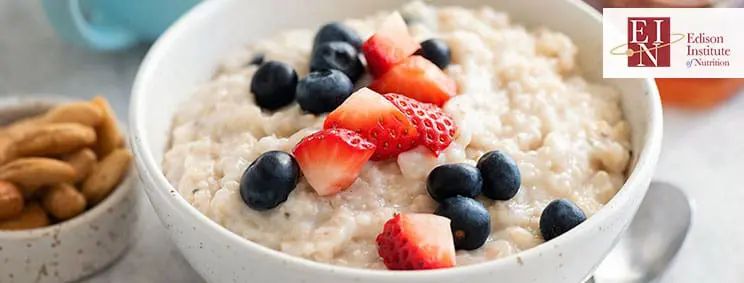
A common refrain when people try to eat healthier is “but it’s more expensive!”
And if you look at fastfood restaurants, this may seem to be the case.
You’ll pay $14 for a salad, when you can spend $5 on a burger and fries.
(Of course, those fast food salads are barely healthier than their counterparts, but that’s a topic for another article)
However, if you take a closer look at food options, and stick to preparing meals at home, it’s not as hard to eat healthy, nutritious foods while on a budget as it might seem at first.
In the introduction to holistic nutrition, program from the Edison Institute of Nutrition, this is just one of the things you’ll learn.
Today, let’s review some of the best values when it comes to inexpensive, healthy food.
Better Nutrition Is For Everyone
No matter your budget, with a bit of planning it’s possible for everyone to eat a healthier, more balanced diet.
It may mean a bit of prep work to avoid the temptation to stop for fast food, but your body – and wallet – will thank you.
While it’s true that some healthier options can be cost prohibitive – locally grown organic grass fed beef, for example, can be pretty pricey – there are still plenty of healthier options available.
As a registered holistic nutritionist, it’s up to you to provide sustainable options to your clients.
Top 10 Most Nutritious & Cheap Foods
Whether you’re trying to feed a family and ensure everyone is getting all of the vitamins, minerals, and nutrients they need, or a student trying to eat on a budget while also maintaining good health to focus on studies, it’s possible to do so without breaking the bank.
Here we will review some foods to consider which ones pack a powerful nutritional punch, while also being easy on your wallet.
1. Onions
Onions are an incredibly versatile veggie.
Roasted, caramelized, grilled, sliced, chopped… the list of ways they can be prepared goes on and on, and they’re a great way to add flavour to meals.
At approximately $1/pound on average they’re also super cheap.
Why They’re So Healthy
This versatile vegetable is rich in antioxidants which can protect against some types of cancer, diabetes, and heart disease.
They also contain vitamin C, vitamin B6, potassium, and manganese.
2. Potatoes
Coming in at about 56 cents/pound potatoes are another super healthy food that won’t break your budget.
Boiled, baked, or mashed, there are so many ways they can be prepared, so they don’t get boring.
Why They’re So Healthy
When you’re prepping your potatoes, leave the skin on to get the most benefits.
They contain vitamins B and C and fibre, as well as minerals such as potassium.
3. Oatmeal
Oatmeal is a versatile breakfast food which can be tailored to your specific taste.
Add maple syrup for a sweet treat, or top with fresh fruit.
It can even be added to smoothies.
Why It’s So Healthy
Oatmeal is full of nutrients and minerals, among them magnesium, zinc, manganese, phosphorus, iron, and B vitamins.
It’s also full of fibre, which is great for reducing the risk of type 2 diabetes, obesity, and heart disease.

4. Oranges
Not just nutritious, fresh oranges are also delicious.
Add them to salads, smoothies, and yogurt or just eat them on their own.
Why They’re So Healthy
Oranges are incredibly high in vitamin C — containing over 100% of the recommended daily intake for this essential nutrient.
They also have B vitamins, calcium, fibre, and antioxidants.
Eating oranges may also help reduce inflammation.
5. Eggs
An incredibly versatile food, there are a huge number of ways which eggs can be served.
Scrambled, poached, boiled, sunny side up, over-easy, the list goes on and on.
And at on average $2-$3 per dozen, a few dollars goes a long way.
Why They’re So Healthy
Eggs are a nutritional powerhouse.
Six grams of protein, vitamins A, B2, B5, B6, B12, D, E, and K, plus folate, selenium, phosphorus calcium, zinc, and healthy fats.
Additionally, eggs are one of the only sources of choline, which is important for brain function.
It’s important to note, however, that eggs are one of the most common food allergies, according to Health Canada.
So if you’re advising your clients to eat more eggs, it’s important to make sure they don’t have such an allergy fist.
6. Spinach
Popeye was onto something with this one — spinach is full of nutrients and is a great way to get your leafy greens.
Add it to soups, salads, or blend into smoothies.
Why It’s So Healthy
Spinach provides vitamins A, C, and K thus making it good for the immune system and bone health.
It’s also full of beneficial plant compounds which reduce inflammation and help to prevent chronic disease.
7. Apples
They say “an apple a day keeps the doctor away” — and while this statement may be hyperbole, there are definitely benefits to eating apples. They contain over 2500 nutrients!
Plus, they’re easy to carry with you and don’t require any prep work, making them easy to eat on the go.
Why They’re So Healthy
Apples have been shown to help with weight loss and control of blood sugar, thanks to their fibre content — a medium apple contains about three grams.
They can also help reduce inflammation, and are a good source of vitamins B and C, as well as minerals and antioxidants.
8. Dried Lentils
Coming in at around 30 cents per serving, dried lentils are definitely an inexpensive addition to your diet.
They can be cooked into soups, stews, and dal, added to salads, made into dips, or dried and seasoned into crunchy lentil snacks.
You can also bake with them and make healthier desserts.
Why They’re So Healthy
One serving of lentils contains 5 grams of fibre, making them a great ingredient if you’re trying to control your weight.
They also contain 12 grams of protein and are a source of vitamin C, calcium, iron, and folate.
Eating lentils has been shown to improve cholesterol levels, and blood pressure.
9. Brown Rice
Coming in at just $2 per pound, brown rice is fast and easy to prepare, and makes a great side dish for any meal.
Add it to a veggie burger patty, to a salad or use it in fried rice — there are a lot of ways to prepare brown rice so it doesn’t get boring.
Rice and lentils together can be a good combo as well.
Why It’s So Healthy
A great source of carbohydrates, brown rice also contains fibre, B vitamins, manganese, magnesium, and phosphorus.
It can help with weight management, as well as reducing the risk of type 2 diabetes.
10. Canned Beans
Beans can be added to just about any dish — there are even recipes for black bean brownies online, and they’re actually pretty tasty.
At under $1 per pound on average, beans are a cheap addition to your diet.
Why They’re So Healthy
Chock-full of fibre and vitamins including potassium, magnesium, folate, and iron as well as being a great source of plant-based proteins, beans are useful for maintaining weight and muscle.
Their ability to help control blood sugar and lower cholesterol means they can help to reduce the risk of diabetes and heart disease.
Contact The Edison Institute Of Nutrition
As a registered holistic nutritionist you’ll be working with clients from all walks of life.
Some will be concerned about how to maintain their healthy diet and lifestyle while living on a tight budget.
The reality is that many will view your services as a luxury – and in a way, that’s understandable.
After all, if you’re a single parent struggling to keep your family fed, the last thing on your mind might be how to optimize your diet for greater health.
But you know that investing in your health today pays dividends down the road, while neglecting it will do the opposite.
Some registered holistic nutritionists offer a sliding pay scale for lower income folks, while others might offer complimentary services – whether you choose to do that is up to you.
However, if you’re going to provide health solutions, they need to be sustainable for your clients.
At the Edison Institute of Nutrition these are the types of issues we’ll help you learn to handle.
Contact us today to learn more about our programs and get started on your career as a holistic nutritionist today.
